Produced by

| President | Julie Merberg |
| Senior Vice President | Patty Brown |
| Layout by | Laura Smyth/Smythtype Design |
| Special Thanks | Sarah Parvis, LeeAnn Pemberton |
POCKET POSH COCKTAILS Copyright 2011 by Downtown Bookworks, Inc. All rights reserved. No part of this book may be used or reproduced in any manner whatsoever without written permission except in the case of reprints in the context of reviews. Andrews McMeel Publishing, LLC
an Andrews McMeel Universal company
1130 Walnut Street, Kansas City, Missouri 64106 E-ISBN: 978-1-4494-0681-3 Library of Congress Control Number: 2010939801 www.andrewsmcmeel.com Illustration by Julie Barnes Cover illustration by robinzingone ATTENTION: SCHOOLS AND BUSINESSES Andrews McMeel books are available at quantity discounts with bulk purchase for educational, business, or sales promotional use. For information, please e-mail the Andrews McMeel Publishing Special Sales Department:
 contents
contents
introduction
Knowing how to make a good cocktail is almost mandatory in polite society today. The good news is that its very easy to learn how to make a drink, and once you understand a few simple precepts, its not hard to learn how to look like a professional while you do it, either.
The instructions in this book are short and to the point, but when you are done reading, you will find that youve been provided all the information needed to impress your friends lined up in front of the bar. Professional bartenders all know that having confidence, and, at the very least, looking as though you know what youre doing, is extremely important when youre standing on the service side of the bar. If youve never held a shaker before, practice the methodology detailed in this book when youre on your own. Use water instead of the real ingredients, and just get a feel for what its like to stir, shake, and strain cocktails and mixed drinks. This is a vast generalization, but drinks served over ice are usually referred to as mixed drinks, whereas drinks served straight-up in V-shaped glasses are known as cocktails. Then, when you do have friends around for cocktails, or a dinner party, and you make drinks for them, youre going to get a pleasant surprise as they watch you mix their cocktails and then take their first sips: The look of admiration in their eyes will be so rewarding, youre going to be very happy that you learned the craft of the bartender.
I envy you that first experience. 
the fundamentals of mixology
Although there are thousands of cocktail and mixed-drink recipes, there are far fewer standard templates on which the majority of these drinks are based. Once you become familiar with the templates, you will understand
why you are adding this to that when you mix a drink, and the recipes will make sense to you. Take, for instance, a simple Daiquiri. Its a mixture of rum, lime juice, and sugar or simple syrup. Rum is the base spirit, lime juice makes the drink sour, and sugar balances out the sourness.
Its a very simple template. Now, if you remove the sugar from the Daiquiri, add a little pineapple juice and a few drops of grenadine, thereby balancing the sourness of the lime juice with different sweeteners, youve just made yourself an El Presidente cocktail. Use Bacardi rum, lime juice, and extra grenadine, and voil, you have a Bacardi Cocktail. Its a simple case of switching out certain ingredients and making sure that you replace them with new ingredients that bear the same flavor profile. If you use gin as a base spirit, lemon juice as a souring agent, and add two liqueurs, maraschino and crme de violette, as the sweeteners, youll end up with an Aviation cocktail. Examine the Dry Gin Martini and you will see that its a marriage of gin, dry vermouth, and (classically) some orange bitters, too.
A Manhattan calls for bourbon or straight rye, sweet vermouth, and usually some angostura bitters. In both cases the vermouth makes the straight spirit more palatable and easier to drink and the bitters add a little extra in terms of complexity. And whats in a Rob Roy? Scotch is the base, then it gets sweet or dry vermouth or both (there are three versions), and a few dashes of Peychauds bitters. The Rob Roy is based on the same template as the Martini and the Manhattan: base spirit, vermouth, and bitters. Some drinks, such as, say, the Black Russian, have just two ingredients, a straight spirit (vodka) for a base and a liqueur (Kahla) as a sweetening agent. Add milk or cream to the drink and you have a White Russian.
Use Baileys Irish Cream instead of milk or cream, and you just made yourself a Mudslide. Now lets look at a group of drinks that all call for vodka and cranberry juice. The first one, the Cape Codder, calls for just those two ingredients, but if you add grapefruit juice, the drink becomes a Sea Breeze. Add orange juice to a Cape Codder instead of grapefruit juice, and youll end up with a Madras; and if you add a little peach schnapps to a Madras, youll find yourself having Sex on the Beach. Not literally, though. My favorite family of drinks has the Sidecar as a base.
A Sidecar is made with a base of brandy, its sweetened by Cointreau, and lemon juice is the sour agent. Remove the brandy and replace it with tequila, use lime juice instead of lemon juice, and there you have a Margarita. Substitute vodka for the tequila in a Margarita, and youll find yourself with a Kamikaze; and if you use citrus-flavored vodka instead, and add a few drops of cranberry juice, youre holding a Cosmopolitan. Those, then, are some standard templates for basic drinks, and once youve learned them, the formulas you see in most other cocktail recipes will make a little more sense to you. Take any drink that you know works, remove one ingredient and replace it with a similar ingredient, and you can almost guarantee that it will work. Just remember that you must replace straight spirits with other straight spirits, liqueurs with other liqueurs, and fruit juices with similar fruit juices, and you wont go far wrong.
Youre on your way to becoming a mixologist. Now you are ready to learn how to shakeem up! 
cocktailian methodology
Why Ice?
Before we get into specifics, its a good idea to take a look at
why mixologists do what they do. For instance,
why do bartenders shake or stir drinks over
ice? To chill them down? Yes. To mix the ingredients together? Yes, that too. However, when you shake or stir a drink over ice you are also adding an extra ingredient to the drink in the form of water melted from the ice. Start out with three ounces of ingredients and, after you chill them over ice, you should end up with a four-ounce drink.

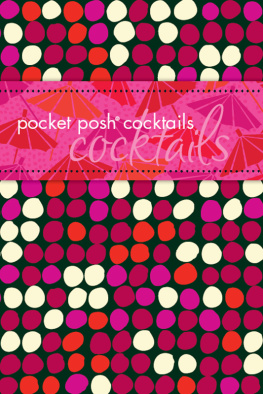
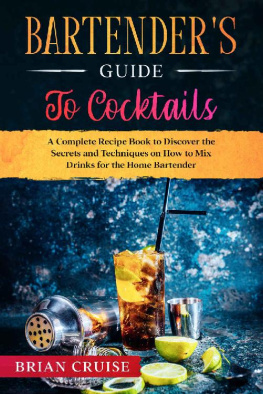
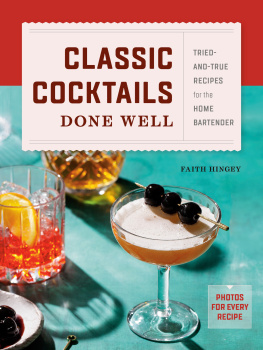
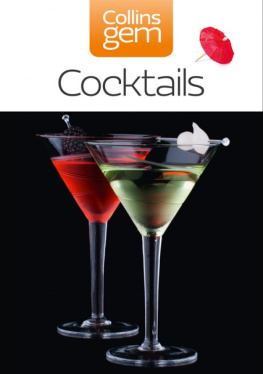

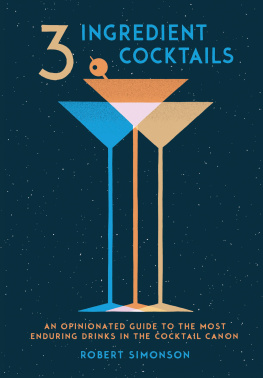




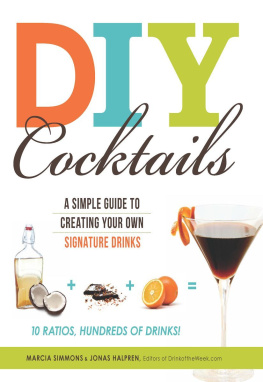





 contents
contents
